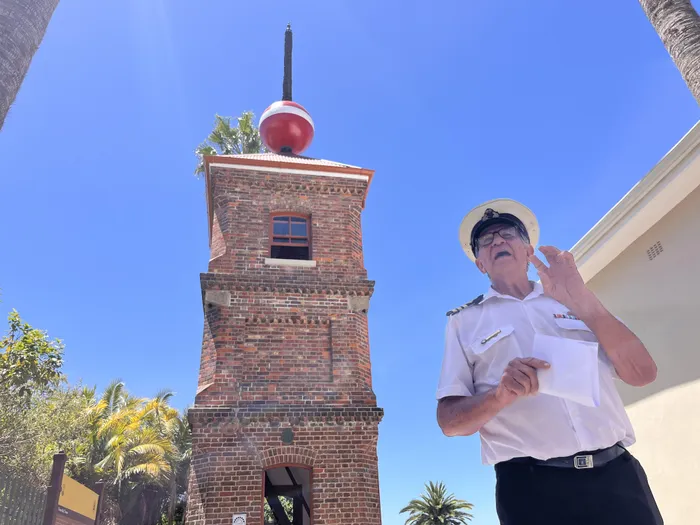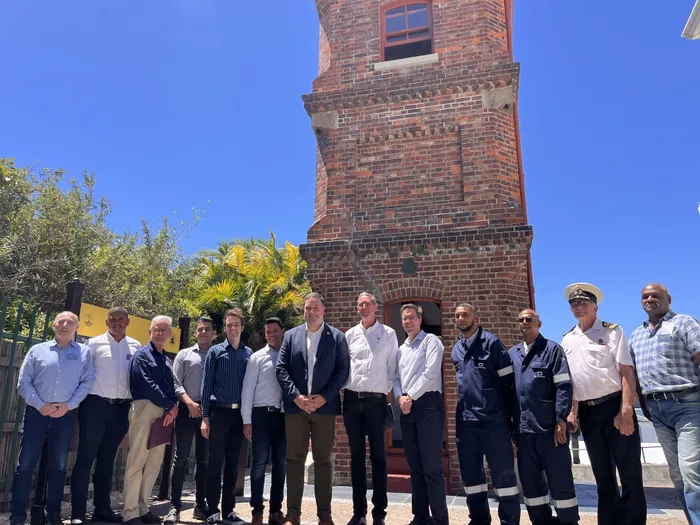Restoration of Cape Town's historic Time Ball Tower revives maritime heritage

Harbour master Steven Bentley.
Image: Fouzia van der Fort
The Time Ball Tower was formally reopened last week after an extensive renovation and refitting, restoring it to its former glory.
The tower, which is a maritime landmark, was erected in 1894. It once helped navigators set their chronometers to calculate longitude accurately, long before the age of the Global Positioning System (GPS).
Every day at 12.55pm, the tower’s time ball was manually wound, with the ball dropping exactly at 1pm, triggered by an electronic signal from the South African Astronomical Observatory. After 30 years, it dropped again for the first time at 1 pm on Thursday, November 13.
Alexios Vicatos, speaking on behalf of his father, Associate Professor George Vicatos - the mechanical engineer who created the drawing for the original mechanism during the 1997 restoration and oversaw the recent restoration - said that Cape Town was among the first places in the world to receive a time ball in 1836.
"Cape Town was also a highly important centre for developing the timeball mechanism that we have today," he said, adding that the mechanism was used all over the world.
"It doesn't only represent a bygone era of a time signalling system for navigation, but it primarily symbolised a highly important historic era of development and perfection of these time ball signalling devices in Cape Town, which would have had a profound impact globally," he said.

Staff and partners of MNA Engineering and Supplies, Thorold Architects, Henry Fagan Consulting Engineers and Project Managers, and Professor George Vicatos brought the time ball back to life.
Image: Fouzia van der Fort
Mr Vicatos said that the inventor, Admiral Robert Walker, was stationed with the Royal Navy in Simon's Town when the first time ball was erected in Cape Town.
He explained that like-minded figures such as Sir John Herschel, the British astronomer, mathematician, chemist, and photographer who lived in Cape Town at the time, and Irish-born Cape Colony astronomer Sir Thomas Maclear, then director of the observatory in Observatory, would have collaborated on erecting Cape Town’s first time ball.
He said that it was important to continue this daily tradition, like the Noon Gun, especially given the historic significance of what the time ball represented for the development of time balls in Cape Town, which undoubtedly had a profound global impact.
The Time Ball now operates as it originally did, manually cranked at 12.55pm and dropping at 1pm.
This revived landmark will operate twice a week, on Mondays and Thursdays, adding a visual time signal to complement the audible Noon Gun.
Visitors can learn more through the free "Reinventing the Tavern of the Seas" audio tour.
The restoration project was a collaboration between the V&A Waterfront, MNA Engineering and Supplies, Thorold Architects, and others.
Steven Bentley, V&A Waterfront harbour master, said: "This allowed navigators on ships in Table Bay to accurately reset their chronometers to correctly calculate longitude at sea and ensure safe navigation.”
David Green, V&A Waterfront chief executive officer, said that preserving maritime heritage symbolises Cape Town’s longstanding role as a global maritime hub and the V&A Waterfront’s ongoing role as one of the world’s oldest working harbours.
"We are proud that the Time Ball Tower will add depth to our city’s tourism and cultural offering by bringing this important piece of history back to life," he said.
Mayor Geordin Hill Lewis thanked the custodians for their commitment to repairing and restoring Cape Town's maritime, naval, and heritage sites, adding that because of the maritime trade, Cape Town exists.
"It is important for us to protect that heritage and leave it to the next generation and future generations of Capetonians with absolute respect for its value as part of our history and part of our story as a people, as a community," he said.